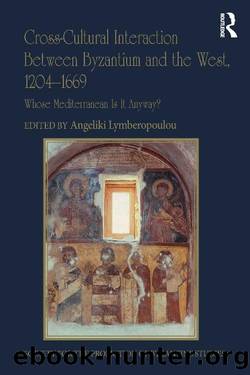Cross-Cultural Interaction Between Byzantium and the West, 1204â1669 (Publications of the Society for the Promotion of Byzantine Studies) by Angeliki Lymberopoulou

Author:Angeliki Lymberopoulou [Lymberopoulou, Angeliki]
Language: eng
Format: epub
ISBN: 9781351244930
Publisher: Taylor and Francis
Published: 2018-03-28T22:00:00+00:00
According to the dedication, the name of the donor is that of the daughter of Michael II of Epeiros, Anna, who changed her named to Agnes when she married William II Villehardouin. Anna, âPrincess of Achaiaâ, donated this manuscript to the church of Hagia Marina, which she had restored in 1277, the year following her husbandâs death. The church of Zoodochos Pege has traditionally been called Samarina, a name that elides the words Santa and Marina. Based on the new date of the narthex wall paintings, c. 1260, it seems that this may be the very church with which Anna was involved. Indeed, Annaâs unusual gravestone, which was found in Andravida in the north-western Peloponnese and combines a Latin inscription with Byzantine carving, recalls the design and technique of the templon screen in Samarina, which has now been re-used, in part, for the churchâs main altar table.60
The katholikon of the Ellenikon monastery at Antheia, dedicated to the Dormition of the Virgin, presents another example of the use of western forms inside a Byzantine church in Messenia.61 The representations of Theodore Tyron and Theodore Stratilatis, and the smaller depiction of Saint Anne holding the infant Virgin, have been known for some time. Of exceptional quality, the military saints are crowned by arches that imitate the design of cosmatesque screens in Sicily, Italy, and on rare occasions, Greece (Fig. 9.11).62
The arches are decorated with slip painting, which created a relief effect through the careful spacing of raised dots, recalling the technique used by the Gkoritsa painter. The remaining decoration of the church, which dates to the end of the thirteenth century, was covered by modern-day plaster until recently. Removal of the plaster on the capitals revealed that they were painted with scenes from the life of Christ. In the representation of the Last Supper painted on the east face of the south-western pier, Christ and His disciples are squeezed into a trapezoidal frame corresponding to the shape of the capital (Fig. 9.12).63
Figure 9.11
Saints Theodore Tyron and Stratelatis under âcosmatesqueâ arches, thirteenth century, wall painting, Ellenikon Monastery, Messenia, the Peloponnese
Photo: author Michalis Kappas
The Washing of the Feet is depicted on the south face of the same capital. The small-scale painting is excellent, and appears to use lapis lazuli for highlights. The Antheia paintings clearly imitate western carved capitals. Although sculpted figural capitals of the period have not been preserved in Messenia, a small marble capital with images of angels was found in the modern church of Saint George in Thebes. This carved capital likely belonged to a church renovated by a Latin donor in the period in which the city was under Frankish rule.64
The large number of unpublished or little-known monuments that we have discussed presents a new view of thirteenth- and early fourteenth-century monumental decoration in the southern Peloponnese, introducing paintings that are different from others found in the region, particularly in stylistic features, colour, and details of iconography. The study of these paintings raises difficult questions about categorisation and terminology. Words
Download
This site does not store any files on its server. We only index and link to content provided by other sites. Please contact the content providers to delete copyright contents if any and email us, we'll remove relevant links or contents immediately.
The Japanese by Christopher Harding(1086)
Watercolor With Me in the Forest by Dana Fox(753)
A Theory of Narrative Drawing by Simon Grennan(742)
The Story of the Scrolls by The Story of the Scrolls; the M(725)
Glittering Images: A Journey Through Art From Egypt to Star Wars by Camille Paglia(717)
Boris Johnson by Tom Bower(620)
This Is Modern Art by Kevin Coval(599)
The Art and Science of Drawing by Brent Eviston(591)
Frida Kahlo by Frida Kahlo & Hayden Herrera(586)
AP Art History by John B. Nici(575)
Banksy by Will Ellsworth-Jones(569)
War Paint by Woodhead Lindy(551)
Van Gogh by Gregory White Smith(547)
Scenes From a Revolution by Mark Harris(544)
Draw More Furries by Jared Hodges(544)
About Looking by John Berger(543)
Ecstasy by Eisner.;(535)
100 Greatest Country Artists by Hal Leonard Corp(524)
Young Rembrandt: A Biography by Onno Blom(514)
